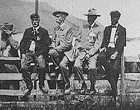The financial and human costs of this transformational conflict were staggering. In 1861, the federal budget of $80.2 million devoted $36.4 million to defense: in 1865, the comparable figures were $1.33 billion and $1.17 billion. Defense spending did not drop below $100 million again until 1871. During the four budget years most impacted by the war-1862 through 1865-a total of $3.05 billion was devoted to defense spending. By war's end, the accumulated federal deficit had grown from $90.6 million in 1861 to $2.68 billion in 1865.
| Year | Federal Budget | Defense Budget | Non Defense Budget | % Devoted to Defense | Annual Deficit | Accumulated Deficit |
|---|---|---|---|---|---|---|
| 1860 | $78 | $29 | $49 | 37 | $13.4 | $64.8 |
| 1861 | $80.2 | $36.4 | $43.8 | 45 | $30.3 | $90.6 |
| 1862 | $485.9 | $437.9 | $48 | 90 | $425.6 | $524 |
| 1863 | $726.1 | $663.6 | $62.5 | 91 | $602 | $1,119.8 |
| 1864 | $878 | $781.5 | $96.5 | 89 | $600.9 | $1,815.8 |
| 1865 | $1,331.3 | $1,170.3 | $161 | 88 | $963 | $2,680.7 |
| 1866 | $536.2 | $343.4 | $192.8 | 64 | -$36.3 | $2,773.2 |
Table 1. Federal Budgets, 1860-1866
All monetary figures in millions
The cost in lives was equally stunning. Over 620,000 Union and Confederate soldiers lost their lives, two thirds of them from disease. In the Confederate states alone, one in every four males between the ages of 16 and 45 was either killed or incapacitated. Americans, both Northerners and Southerners, black and white, came face to face with battlefield slaughter and death as never before (or since) in the nation's history. A comparable loss today would result in the deaths of over 6 million Americans. And these casualty figures do not account for an undetermined number of civilians who were killed during the conflict.
This carnage dealt a mortal blow to the "slave power," an economic and social system that had horrific human consequences and had glaringly contradicted the aspirations of many of the Founders toward equality. More than four million men, women, and children who had known no other life than slavery suddenly found themselves freed. By the end of 1865, the 13th Amendment's succinct guarantee that "Neither slavery nor involuntary servitude . . . shall exist within the United States, or any place subject to their jurisdiction" made moot the provisional nature of Abraham Lincoln's wartime Emancipation Proclamation. Within five years, the 14th and 15th Amendments solidified the newly emancipated slaves' autonomy with guarantees of citizenship and the right to vote. Despite these constitutional protections, most former bondmen and women soon found themselves driven by terror, peonage, and discrimination back into a world of circumscribed possibilities. It took another century until the full force of the federal government was brought to bear on behalf of constitutional guarantees of equal protection and voting rights for African Americans.



